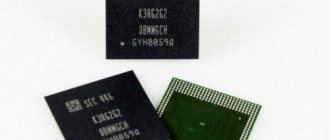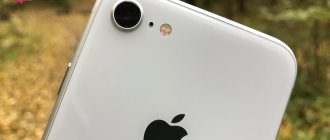Modern mobile devices are equipped with numerous sensors that significantly expand their functionality. Device users often don’t even realize that there are some built-in sensors, much less have any idea about their purpose. Proximity, lighting sensors, accelerometer, gyroscope and other integrated sensors, which even budget models have long been equipped with, are usually known to device owners, but when encountering unfamiliar solutions, users do not know how they can be useful and how to use them.
Relatively recently, manufacturers of mobile devices began to integrate geomagnetic field recorders, allowing the phone to be used as a compass and determine the cardinal directions using special software.
Magnetic sensor in a smartphone: what is it and how does it work?
Modern phones are very similar to computers - they are designed according to a general principle: motherboard, processor, video adapter, RAM.
But the main difference is the numerous sensors that no smartphone can do without: accelerometer, gyroscope, barometer, temperature sensors, proximity light sensors, etc. They all make your phone easier to use and smarter. Today we will talk about the features and purpose of the magnetic sensor in modern smartphones.
Why is a magnetic sensor needed?
This sensor is also called a Hall sensor. The Hall effect was discovered almost 150 years ago, but is actively used in various techniques to this day. The Hall sensor detects a magnetic field, thanks to which it can determine the position of the smartphone in space. So, a smartphone can become a compass - just download a special application from Google Play (just search for “compass”).
In the middle of the last century, the Hall sensor was used in cars - this was the first step in introducing such technologies into human life. Further, the development began to be used in other areas, including mobile technologies.
The magnetic sensor is convenient when combined with a case with a magnetic clasp/latch. Due to this, you can save time, since the phone screen will automatically turn off when closed and turn on when the accessory is opened. If the case has a window, the space not covered by it can be active, that is, it will be possible to check the time, applications and some widgets without opening the case and unlocking the smartphone. It should be noted that the magnet does not harm the sensor or other sensors or components of the phone in any way.
How to enable the magnetic sensor on your phone?
Most flagships, produced by both large brands and more budget companies, have a magnetic sensor. It works automatically. You can check the presence of technology in the technical characteristics of a specific device or through simple tests:
- You can imitate a magnetic case by attaching an ordinary magnet to the phone screen. If the display goes dark, the magnetic sensor has tripped.
- Download the compass app, turn off the internet and check if it will work. UPD. It should be noted that in the case of the compass we are talking about a more advanced geomagnetic sensor.
Source
Magnetic and geomagnetic sensors
Modern smartphones are equipped with various sensors that make the devices more functional and allow them to perform certain actions. Their work is not noticeable to the user, but if they are absent, the device loses its power, its range of options is sharply reduced. So, what is the main purpose of these elements? This question worries many mobile device owners.
But modern models use many new sensors that are used to control temperature, measure the geomagnetic field, track the position of the device in space and other functions. They significantly simplify the use of a smartphone and make it smarter.
Why is it needed?
This device is used in many devices. Due to the possibility of contactless measurement, the device is most often used in electric motors, in the ignition system of modern cars, contactless switches, etc. Any fairly modern smartphone cannot do without it, although it is impossible to fully realize its potential for several reasons:
- small size mobile phone;
- Constant operation significantly battery life
- no special need .
The main reason for using a Hall sensor in smartphones is the convenience of using a GPS navigator and its interaction with a smart phone case.
What is it and what is it for?
A magnetic sensor is a sensor built into a phone that reacts to the Earth’s magnetic fields, and it picks up electromagnetic radiation. Using a magnetic sensor, you can determine the cardinal directions and find out the current direction of the device, which is why it is often called an “electronic compass.”
This sensor is referred to as a Hall sensor. The Hall effect was discovered a long time ago, almost 150 years ago, but it is still used in various techniques. It detects the magnetic field, due to this it can determine the position of the mobile device in space. And if you download a special application from the Google Play or App Store onto your smartphone, it can become a full-fledged compass for determining coordinates.
useful links
- https://ru.wikipedia.org/wiki/Hall_Effect
- https://arduino-kit.ru/catalog/id/modul-datchika-holla
- https://www.14core.com/wiring-hall-effect-sensor-switch-magnet-detector-module/
- https://robocraft.ru/blog/arduino/57.html
- https://arduino-kit.ru/catalog/id/modul-na-osnove-gerkona
- https://www.zi-zi.ru/module/module-ky021
- https://2shemi.ru/mehanicheskie-datchiki-dlya-arduino/
- https://electrosam.ru/glavnaja/slabotochnye-seti/oborudovanie/gerkony/
- https://electrik.info/main/school/419-gerkony-sposoby-upravleniya.html
- https://arduino-kit.ru/catalog/id/modul-datchika-holla-_lineynyiy_
- https://www.zi-zi.ru/module/module-ky024
- https://arduino-kit.ru/catalog/id/modul-magnitnyiy-datchik-s-gerkonom
- https://www.zi-zi.ru/module/module-ky025
- https://arduino-kit.ru/catalog/id/modul-datchika-holla_
- https://ru.wikipedia.org/wiki/Gauss_(unit)
All documentation and program files are located in a common archive. Review prepared by Denev.
We present to your attention a large selection of instruments for detecting and measuring electromagnetic radiation, as well as current probes and other measuring equipment. Induction and other electromagnetic radiation detectors are widely used in navigation systems, measuring the angle of rotation and direction of movement, determining coordinates, and other equipment.
How to check availability
Not everyone knows whether a smartphone actually has a position sensor, but this component is used in many modern devices.
And to find out whether it is installed in the device or whether the device still does not have a magnetic sensor, you can use the following detection options:
- An easy way is to check in the technical settings of your smartphone. They will definitely indicate whether the device has a magnetic element;
- You can install the Compass application on your gadget; it can be downloaded from the Google Play store (Android) or App Store (IOS). If, after downloading and installing, it starts working and performs basic functions, it means that the device has a magnetometer;
- An easy method - you can bring a regular magnet to the device display. If the device responds, it means that a geomagnetic sensor is installed in the smartphone.
Magnetometer
The last of the three sensors for orientation in space is a magnetometer. It measures magnetic fields and can therefore determine where north is. The compass function in various map applications and some compass programs work using a magnetometer.
Metal detectors have similar sensors, so you can find special applications that turn your smartphone into such a device.
The magnetometer works in tandem with the accelerometer and GPS for geo-location and navigation.
How to use
Despite the fact that many models of modern smartphones have a geomagnetic sensor, not all have a program for its use. And in order for the user to enable it and start using the capabilities of this element, he must download a third-party application. The compass for Android can be downloaded from Google Play, and for iPhone from the App Store.
The program is installed automatically. Then you can open it and allow access to the data. You can also read the instructions for using the application, learn the principles of setting up and operating the compass. But in general, many programs have a simple interface and have a built-in sensor calibration function.
Other types of sensors
Smartphones often use various sensors that allow additional functions. Among the popular ones are the following:
- Accelerometer or G-sensor. It helps the gadget determine its position in space and the distance of movement. The element performs auto-rotation of the screen orientation, responds to gestures, and can also count steps and help with orientation on maps;
- Gyroscope. Helps determine the position of the smartphone in space. It does this by identifying its own angle of inclination relative to the surface of the earth;
- Proximity sensor. It will help to determine the presence of some object in front of it;
- Light sensor. Automatically adjusts screen brightness;
- GPS. Works with satellites, helps determine the location of the smartphone and the object.
Magnetic sensors are a useful and unique invention that makes smartphones easier to use. They make them functional, convenient, and technologically advanced. But in order to use them correctly, you need to first consider the characteristics and control features.
Use as a metal detector
The magnetic sensor can be used as a simplified metal detector. To do this, the user will need to download a special application (search on Google Play). Using a magnetic sensor and software, the phone will be able to determine the location of metals.
However, you should not expect miracles from such technology. The distance at which the magnetic sensor operates as a metal detector is from 3 to 30 centimeters. In addition, metals underground or wiring in thick walls cannot be detected this way.
Using the compass on your phone
The compass is not always a standard feature of a smartphone, but if you have a magnetic sensor, you can add the option by installing a special application from the Google Play store. You can read about the capabilities of a third-party tool in the software description. The compass will need to be calibrated for accurate readings.
In Google Maps, thanks to the compass, the user sees an arrow indicating the direction of the cardinal direction in which the smartphone is turned. If the compass is calibrated, the beam will be narrow, and if calibration is necessary, it will be wide, and the application will warn you that the action must be performed. The procedure involves drawing a figure eight in the air with your phone.
Source
Geomagnetic sensor in a phone - why is it needed and how is it used?
A geomagnetic field sensor is a smartphone part that is necessary for measuring magnetic fields. Using this sensor, the phone can work as a compass, and its accuracy will be increased. A distinctive feature of the geomagnetic sensor is its more advanced design than that of a magnetic sensor. Because of this, the direction of the phone is determined more accurately, which means orientation is easier.
A geomagnetic sensor (magnetometer) is also called an electronic compass. It is used to determine which direction the phone is facing. At the same time, a more advanced geomagnetic sensor allows even phones without GPS to determine the direction of movement, as well as location. However, to do this, the Wi-Fi network must be turned on, and mobile base stations must be available.
Based on their operating principle, magnetometers are divided into 3 types:
- Magnetostatic.
- Induction.
- Quantum.
Each variety reacts to an external magnetic field using a specific physical principle. Based on these three varieties, various highly specialized types of magnetometers have been created, which are more accurate for measurements under certain conditions.
Magnetostatic magnetometers
The principle of operation of these M. is based on mechanical. the effect of a magnetic field on a magnet. Such instruments include a magnetic compass and a compass, which determine the direction of the Earth’s magnetic field, quartz variometers, which make it possible to record geomagnetic variations with an accuracy of 10–3–10–4 A/m, and magnetic balances, used in laboratory conditions to study the magnetic susceptibility of samples. In magnetic balances, the susceptibility of a magnetic material is determined by the force with which the test sample, shaped like a long cylinder, is drawn into the field of an electromagnet (Gouy's method), or by the force acting on a small sample placed in a non-uniform magnetic field (Faraday's method). The Gouy method requires a larger mass of substance (1–10 g), while the Faraday method allows you to work with milligrams of substance and requires more complex equipment.
Induction magnetometers
The work of these magnets is based on the phenomenon of electromagnetic induction; they register changes in the flux of magnetic induction in the meter. coil caused by diff. reasons. Induction magnets are conventionally divided into passive and active: in the first, the emf in the coil is excited by changes in the external magnetic field over time, and in the second, by changes in the device itself. Passive M. are a long cylindrical. a coil wound on a ferromagnetic core and are actually ultra-low frequency antennas. Such magnets are used for detecting nuclear explosions, communicating with submarines, and magnetotellurics. probing the earth's crust, studying the interaction of the solar wind with the Earth's magnetosphere and wave processes in space. plasma.
Active induction magnets include, for example, a rock generator and a fluxgate magnet. In a rock generator, the sample under study is placed on a special surface. a platform rotating in the center will be measured. coils with a frequency of 40 Hz. As a result, an emf appears in the coil, the magnitude of which is proportional to the magnetization of the sample. To eliminate the influence of an external magnetic field on the measurement results, the coil (together with the rotating platform and the sample) is covered with a multilayer permalloy screen. The rock generator is used in studies of the magnetic properties of rocks, for example. in the study of paleomagnetism.
Fluxgate M. are based on periodic. changes in the magnetic permeability of ferromagnets during magnetization reversal (until saturation) by an alternating excitation field. Alternating current is supplied to the excitation winding; at the same time it will measure. The coil is induced by an emf variable, the even harmonics of which are proportional to the longitudinal component of the external field. The simplest fluxgate sensor consists of a ferromagnetic rod core and measurement and excitation windings located on it. The most common fluxgate magnets use a toroidal core with an excitation winding or two rod cores with excitation windings distributed along their length, connected in series and counter-current (that is, electrically in series, but the magnetic fields created by the windings have the opposite direction). Measurements are made either using one common signal winding, or using two windings connected so that odd harmonics. the components of the magnetic field are practically compensated. The use of a toroidal core makes it possible to simultaneously measure 2–3 mutually orthogonal components of the magnetic field, which reduces errors in determining the direction of the field vector.
Fluxgate magnets are used to measure the Earth's magnetic field and its variations in aeromagnetic surveys and mineral exploration, and in space exploration. research, surgery, product quality control systems, electronic compasses. The sensitivity of fluxgate M reaches 10–4–10–5 A/m.
Quantum magnetometers
Quantum magnetometers use quantum phenomena: free ordered precession of nuclear (nuclear magnetic resonance, NMR) or electronic (electron paramagnetic resonance, EPR) magnetic moments in an external magnetic field, quantum transitions between magnetic sublevels of atoms, as well as quantization of magnetic flux in a superconducting circuit . Depending on the method of creating macroscopic. magnetic moment and signal detection method are distinguished: proton magnets (free precession magnets, with dynamic and synchronous polarization), optical magnets. pumping, etc.
The proton magnet sensor is a container with a diamagnetic liquid, the molecules of which contain hydrogen atoms. Such a liquid can be water, kerosene, benzene, heptane, etc. An ampoule with liquid is placed in a coil, or the coil is immersed in a container with working fluid. A polarization current is first passed through the coil, which creates a magnetic field that orients the magnetic moments of the protons and magnetizes the liquid. After the polarization current is turned off, the magnetic moments of the protons begin to precess around the direction of the measured magnetic field H meas with frequency ω = γpHmeas, where γp is the gyromagnetic ratio for protons. Thus, measuring the precession frequency makes it possible to determine the magnetic field strength with high accuracy.
In the work of quantum magnetism, the precession in a magnetic field of the magnetic moments of unpaired electrons of paramagnetic atoms can also be used. The precession frequency of electrons is hundreds of times greater than the precession frequency of protons. Proton microscopes have been created in which EPR increases the intensity of NMR (Overhauser effect).
Quantum optical M. (optically pumped M.) is often called simply quantum M. The sensor of the device is a glass flask filled with alkali metal vapor (for example, Rb, Cs, K), the atoms of which are paramagnetic. When light with circular polarization and a wavelength corresponding to the transition of metal atoms to one of the excited levels is passed through the flask, the atoms fill one of the magnetic sublevels of this level, which leads to a decrease in the resonant absorption and scattering of light. When the flask is placed in an alternating magnetic field with a frequency ω = γeLism (γe is the gyromagnetic ratio for electrons), the population of magnetic sublevels is leveled out, and the absorption and scattering of light increases sharply. The sensitivity of proton and optical magnetism is 10–4–10–5 A/m.
All described quantum measurements are used to measure the strength of weak magnetic fields, including the geomagnetic field in space. space, as well as in geological exploration.
The operating principle of superconducting quantum magnetometers (SQUID magnetometers) is based on quantum effects in superconductors: quantization of the magnetic flux in the superconductor and the dependence of the critical value. contact current of two superconductors from Nism (see Josephson effect). Superconducting magnets measure ultra-weak magnetic fields and are used in biophysics, solid-state physics, magnetochemistry, and others, as well as for measuring geomagnetic field components. The sensitivity of SQUID magnetometers reaches 10–10 A/m.
How to use the geomagnetic sensor on your phone?
The geomagnetic sensor in the phone is used using a special application called “Compass”. Usually it is preinstalled on a mobile device, but analogues can also be downloaded from Google Play. However, the application will not work if the phone does not have a geomagnetic sensor. You can find out if it is built in in different ways:
- In the technical characteristics of the phone.
- On the manufacturer's website.
- Using a device specification application, such as CPU X.
You need to look for the names “geomagnetic sensor”, “magnetometer”, “geomagnetic field sensor” or “magnetometer”.
To use the geomagnetic sensor, you must install or open the Compass app if you already have it installed. Then the sensor will start working on its own. In some cases, the app will require you to calibrate the compass, but this is easy to do by simply following the on-screen instructions.
MAGNETOMETER
MAGNETOMETER, a device for measuring the characteristics of a magnetic field and the magnetic properties of objects and materials. Some M. have special. names depending on the measured value: oerstedmeters measure the magnetic field strength, gradiometers and variometers - changes in strength in space and time, inclinators and declinators - the direction of the intensity vector, teslameters - the magnitude of magnetic induction. M. also measure the following characteristics of objects and materials: magnetic permeability and magnetic susceptibility (mu-meters and kappa-meters), coercive force (coercimeters), magnetic flux (Webermeters or fluxmeters), magnetic moment, magnetization curves, hysteresis losses and etc. Often magnetometric. sensors are used for indirect measurements of non-magnetic quantities.
Hall sensor (magnetic) in a smartphone - how to use it and how it works
Smartphones use a huge number of different sensors and sensors, and the average user doesn’t even know about some of them. In this article I want to talk about just such a “gray horse”.
A Hall sensor is present in most modern smartphones. You can determine whether you specifically have it or not in several ways: uninteresting - look on the Internet, interesting - turn on the device and hold a magnet over it; if the smartphone is locked, the sensor is available.
How does it work
As you can guess from the name, the sensor is associated with a physicist. Namely, his work is based on the Hall effect. The sensor can sense the electric field and measure its voltage. If we delve deeper into the process itself: then when a conductor with a constantly flowing current is placed in a magnetic field, a potential difference will arise in it (this is detected by the sensor). But in smartphones everything is much simpler, here the sensor simply determines whether there is a magnetic field or not.
Contrary to popular belief, it is not the Hall sensor that is responsible for determining the cardinal directions (compass) in smartphones, but a magnetic sensor, which is often installed with it.
What is the sensor used for?
In fact, in smartphones the sensor is used in two situations: in combination with a magnetic one, it helps to determine the cardinal directions, quickly determine the location, and for special cases. You can look at them in more detail. A magnet is built into the case (sometimes with special information) and when you open/close it, the smartphone turns on/blocks accordingly. Moreover, if the case has a “window” or other features, the smartphone adapts to it.
By the way, if you have an ordinary case, you can “bump” it inside yourself! a magnet opposite the Hall sensor and now your smartphone will be obediently turned on. and off on one's own.
If you were interested and the information was useful, like and subscribe to the channel - this will help you see the next episodes, which will be even cooler. I also recommend reading about the distance sensor in your smartphone.
Source











